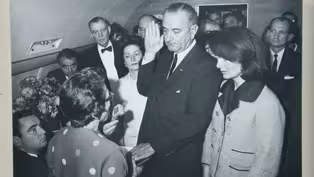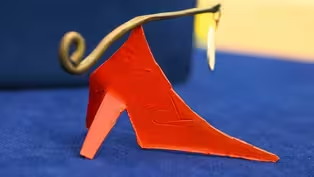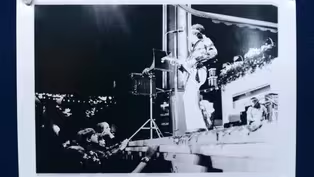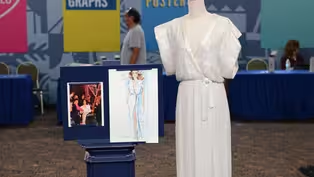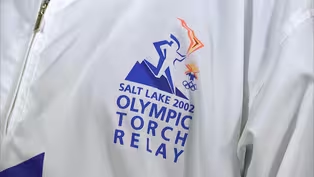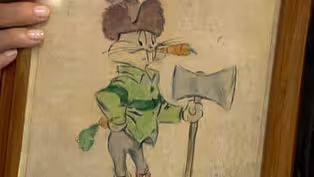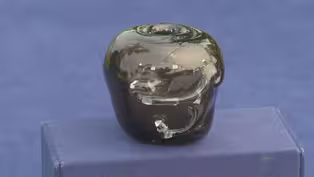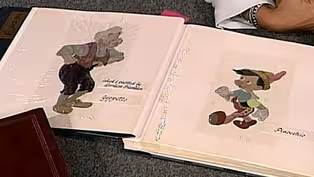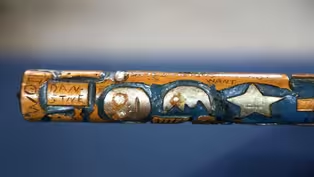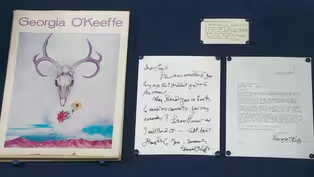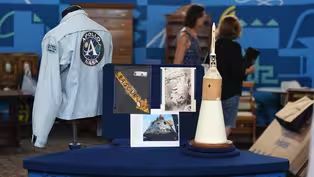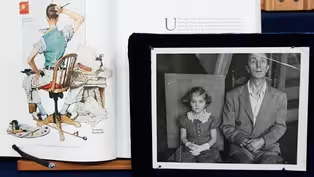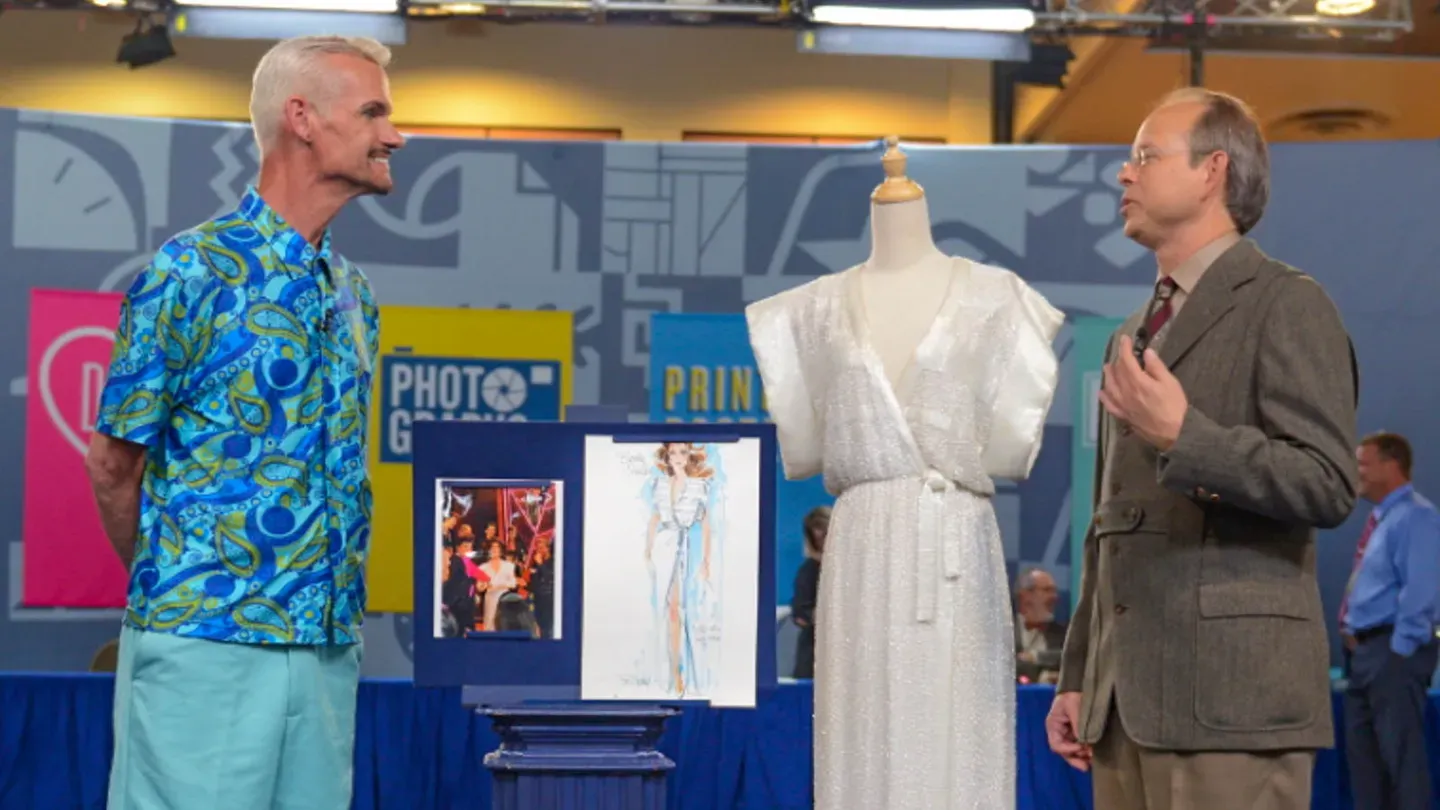

I Was There
Season 28 Episode 22 | 52m 28sVideo has Closed Captions
Hear ROADSHOW guests’ stories and see some incredible mementos from their experiences!
Hear ROADSHOW guests’ stories and see some incredible mementos from their experiences, including Disney animation art, ca. 1938, a 1970 Jimi Hendrix collection, and a Norman Rockwell oil painting and chair, ca. 1952. One is $230,000.
Problems playing video? | Closed Captioning Feedback
Problems playing video? | Closed Captioning Feedback
Funding for ANTIQUES ROADSHOW is provided by Ancestry and American Cruise Lines. Additional funding is provided by public television viewers.

I Was There
Season 28 Episode 22 | 52m 28sVideo has Closed Captions
Hear ROADSHOW guests’ stories and see some incredible mementos from their experiences, including Disney animation art, ca. 1938, a 1970 Jimi Hendrix collection, and a Norman Rockwell oil painting and chair, ca. 1952. One is $230,000.
Problems playing video? | Closed Captioning Feedback
How to Watch Antiques Roadshow
Antiques Roadshow is available to stream on pbs.org and the free PBS App, available on iPhone, Apple TV, Android TV, Android smartphones, Amazon Fire TV, Amazon Fire Tablet, Roku, Samsung Smart TV, and Vizio.
Buy Now
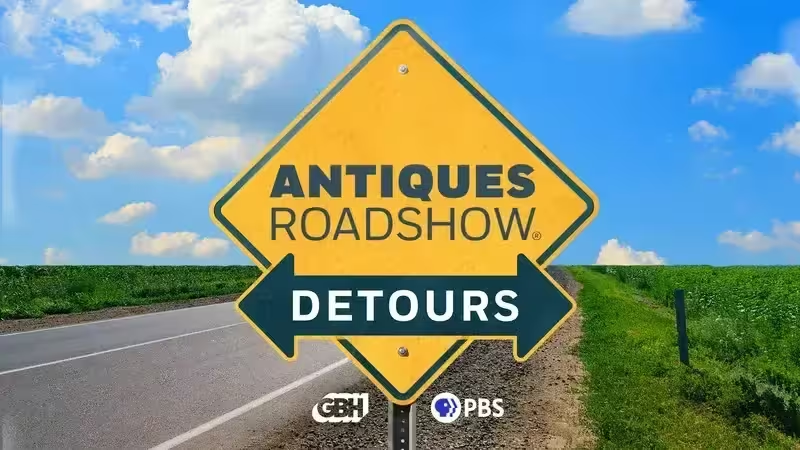
ANTIQUES ROADSHOW DETOURS
Ever wondered what happens to the treasures featured on America’s beloved ANTIQUES ROADSHOW after the cameras leave town? Host Adam Monahan tracks down the juicy afterlives of your favorite finds from PBS’s hit series.Providing Support for PBS.org
Learn Moreabout PBS online sponsorship♪ ♪ CORAL PEÑA: We've got treasures that are proof of being at the right place at the right time.
In 2002, I got to run the Olympic torch.
PEÑA: Find out more right now, in "Antiques Roadshow: I Was There."
♪ ♪ PEÑA: What was it like to be in the presence of a famous figure... APPRAISER: You've brought a, a number of Georgia O'Keeffe items signed.
What's your connection?
Well, when I was young and crazy, I was invited to work for her for a while as a cook.
PEÑA: ...or to be a part of an historic achievement?
I was in quality control.
I tested everything before the astronauts would come in the spacecraft.
PEÑA: These "Roadshow" guests were a part of momentous occasions.
It was taken at Travis Air Force Base on March 17, 1973.
This was the first moment we saw my dad... (swallowing): ...when the aircraft landed.
PEÑA: And some were close to greatness.
I was actually right behind, uh, Jimi Hendrix's bell bottom there.
PEÑA: In this special episode of "Roadshow," we'll hear their stories and see some incredible mementos from their experiences.
Take a look.
Now, when I saw you approaching me at the paintings table with this chair, I thought possibly you'd been misdirected, but it seems there was a reason.
The chair kinda goes with the collection, because the chair belonged to Norman Rockwell, and the, the paintings are by Norman Rockwell.
And then you produced this little painting here... Mm.
...inscribed, "My best wishes to Chickie Pelham... Mm-hmm.
...from Norman Rockwell."
Mm-hmm.
And she looks somewhat familiar.
(both laugh) Yeah, I was supposed to be on the cover of the Kellogg's corn flakes box.
And so Norman did two paintings, my brother and myself, and he sent them out to Kellogg's.
And they didn't choose them because they said we were kinda too pretty, that they wanted more wholesome, all-American-looking kids.
They wanted red hair and freckles.
So they sent the paintings back to Norman.
Aw.
And he gave them to my dad, 'cause my dad was his photographer.
You look very wholesome there, you know.
I'm sorry you didn't make the cut.
(laughs) And you mentioned your father was a photographer.
Yes.
And here we see this is you and, and the artist.
Is that correct?
Yes.
Oh, right.
That's me and Norman, yeah.
And you did other modeling?
Yes, I was the baby in the babysitter painting.
My mom told me many, many years later how bad she felt because they had to stick my feet with pins to make me cry.
Ooh.
And she just thought that was wrong, but they couldn't figure out any other way to make me cry, I guess.
Then I posed for some Christmas cards and then the DuMont television ad.
What was it like being a model for Norman Rockwell?
It was wonderful.
I went there so often that I just became very familiar with his studio, and he had a Coke machine in his back room.
And we weren't allowed to drink soda in my home, only on special occasions.
So when I was modeling, it was like, okay, this is great.
He was very kind, and he was soft-spoken, but he was very detailed in the way he wanted you to sit, and so you had to sit very still once he got you into a position.
Right.
And then the photograph would be taken.
But he took many, many photographs.
For instance, for this sitting, I sat over 15 hours, but it wasn't constant.
There would be breaks in between, but it was a long day.
Right.
Now, there's a little, uh, letter that...
Yes.
...your father received from the artist.
Right.
Can you maybe read what that says for us?
Sure.
It says, "Dear Gene, At long last, "everything in connection with the DuMont television film "are settled, and enclosed is a check for $15.50 "to reimburse your daughter for her long session of posing.
"Give her my thanks for helping me out.
Sincerely, Norman."
Have you any thoughts about what the value of these pieces might be?
About 30 years ago, I, I acquired the painting, and at that time, I had it appraised.
Right.
And I think they said it was a, worth about maybe $35,000.
Right, which I think back then was most likely an, an insurance figure.
Probably.
Yeah, I don't know.
Yeah, I think you have in that.
I would say, for insurance, you're probably looking at somewhere in the sort of $80,000-$90,000 range.
Oh, okay.
The record is now around about $15 million.
Yes.
And this piece here is, is a reproduction print.
And there's no intrinsic value to that.
No.
The letter with it adds value to it.
I would think probably a few hundred dollars.
Mm-hmm.
For a signed letter from Rockwell.
Mm-hmm.
The chair.
Now, how did you come by the chair?
My dad was always bringing stuff home that Norman was throwing out.
And here, interestingly, there's a chair there.
And here it is again here, in, in one of his best-known works.
Yeah, right.
How much do you think the chair might be worth?
I have no idea.
Well, candidly, nor do I. Yeah.
(laughs) So I spoke to my fellow appraisers in the collectibles area, and they told me it would make at least $50,000.
You are kidding.
Oh, my goodness.
Well...
It's pretty iconic, really, from this painting.
Oh, my... (laughs) And to think of the amazing paintings that he did when he was sitting in this chair.
(exhales) I thought maybe a couple of thousand dollars.
A little bit more, apparently.
(laughs) So... (chuckles) Oh, my gosh.
I brought two albums.
One is the animation that I inked as an inker in 1939 with Disney Studios.
You worked in the studios?
Yes, I did.
And your job at the studios was to actually take the paint and apply it to the, to the animation cels?
I... That, and I was an inker, too.
An ink...
The lines that go around?
Yeah, uh-huh.
And how long did you work at the Disney Studios?
Several years.
I, uh, worked on "Pinocchio" and "Fantasia" and "Bambi," and, and later on, I worked on "Sleeping Beauty."
Each girl was given a sequence to ink, and they were timed before you received them.
And each picture was timed by another girl.
And you were to keep up with those, uh, timing, and, uh, it was counted for or against you.
And, uh, if you didn't keep up on their time, you were let go.
But, uh, it kept you on your toes.
You had to listen to a radio through earphones so that you wouldn't slow down by talking to someone.
And how many cels would you say you painted a day?
Say 35 to 65.
That's a lot of work for a day.
Mm-hmm.
It was fun, though.
Good.
Yeah, I really enjoyed it.
Disney now uses computers.
Mm-hmm.
So they no longer have people to hand-ink and paint them.
So that makes them and yourself and your career that much more special.
The thing about these is, you can see how the movie was really made.
It's an interesting historical book, to actually look through the whole book and to be able to see... Mm-hmm.
...how much work it, is involved.
And then here you have some practice tests.
Mm-hmm.
Which I think is really interesting, because these aren't the colors that they used in the film.
Mm-hmm, yeah.
This book I found fascinating, as well.
It's a wonderful collection of animation drawings.
This particularly is from "Snow White."
And the whole book is filled with things that, um, are very similar to this, and I was quite impressed.
Mm-hmm.
Uh, these are from "Pinocchio."
With your collection of animation drawings, it's really neat.
Mm-hmm.
I, if you add everything up, the cels are actually the things that are the most valuable.
Unfortunately, they've been cut down, and they're not on their full sheets.
And the animation drawings, unfortunately, have been trimmed, as well, but if you go through the entire book and you add up the whole collection of animation cels and the drawings, the whole collection itself is worth about $15,000 to $20,000.
Oh, that sounds good.
(both chuckle) This is a Nazareth band.
I drove 'em in a cab.
And I got the signatures here.
How long ago did you drive in the cab?
'70s.
Yeah?
1970-- and this is actually an album... Yeah.
...of the-- them in the cab.
And I drove them, and this is the actual, uh, ticket that I signed it.
Uh, that they signed, I gave it to 'em, and they-they all signed it.
Very cool.
And this is a poster from when I chaired, uh, an event in Minnesota which welcomed Raisa Gorbachev.
And this is one of the posters that was hung up to direct the press to follow them to their locations.
GUEST: Well, it all started when I was eight years old.
I went to try out for the Little League, and they had a Yankee bat boy contest.
Well, girls couldn't participate, so I made up a name, I put Jimmy Lotze.
So when they called my house, my mother answered the phone.
They said, "Oh, your son Jimmy just won the Yankee bat boy contest," and my mother started to laugh.
She said, "Well, I don't have a son, Jimmy, but it's my daughter, Nancy."
So when they found out, they were like, "Wow, we've got to do this.
You know, make her the honorary bat girl."
So they said to me, "Who's your favorite Yankee?"
And I said, "Oh, Mickey Mantle."
And it just so happened that Mickey Mantle came to speak to me.
APPRAISER: And obviously, you, uh, two became friends.
Here you were giving him a peck on the cheek.
Oh yes, yes.
And I had asked him, "Oh, Mickey, can you hit a run, a home run for me?"
He said, "Well, I can't promise you anything."
I said, "That's okay!"
And he hit a home run, and he came over to me.
He said, "Here, Nancy, here's my bat."
And then a few weeks later, I get this autographed picture in the mail.
"To Nancy, the cutest bat boy we have ever had.
your pal, Mickey Mantle."
It's incredible.
I was so excited to see this, this is such a wonderful story.
This happened in 1963.
Yes.
Yes.
You really can't get a better bat than this.
A home run bat, this kind of documentation.
Mm-hmm.
Here you are with the Mick, here you are in "Life" magazine.
Yes.
I think with all this backup documentation, this fantastic photo, at auction, I would expect a bat like this to go for about $35,000.
It's truly a fantastic piece.
One of the best pieces...
Thank you.
I've seen on this show.
Thank you!
Thank you, yes, I mean, my memories are awesome.
GUEST: I started out at North American Aviation as an inspector, and I worked myself up to an engineer.
I started collecting the photos after Apollo 1 burned up.
When I went to the Cape, a-and the launch team, they sold us these jackets.
I mean, we didn't have to buy 'em, but we just all wanted to wear 'em, so we all bought these jackets.
APPRAISER: Do you remember what you paid for the jacket?
Yeah, I think it was 40 bucks, which was a lot of money in the '60s.
Mm-hm.
(laughing): You know, so...
So, but it was, it was worth every penny.
What was your role with... with...?
(stammering): I was in quality control.
I tested everything before the astronauts would come in the, in the spacecraft, and that's what I'm doing in that one picture there.
I'm, uh, firing these rockets right here on the service module.
This is command module, this is the service module, and I'm firing these little 100-pound thruster engines.
If we pick this up, it's just, it's in a couple of pieces, but you can see that that's the...
Yes.
So you're in the command module?
I'm in the command module.
Firing that.
This is the Apollo without the first and second stage rocket.
How did you acquire this particular model?
Oh, it was given to me years ago.
Uh, I just earned it, like.
And then, so I just started getting all the astronauts to sign it.
You've captured 15 astronaut signatures... Yeah, yeah.
...on the capsule portion of this.
Right.
And so you were friends with them all and...?
I was good friends with them, I met 'em in the early '60s.
We had to go through classes together, so I got to know 'em on a personal basis, and they're crazy guys, so we had a lot of fun.
Okay, and then this was a, a North American Aviation...
Yes.
...Apollo spacecraft model-- it's the executive model, is what, is what it's referred to as.
Yes, yes.
Talk about the North American Aviation Group relative to NASA.
Well... How did those two organizations work together?
They gave us the contract, and we interpreted the contract and, and then had get the approval for the design and everything, and then we built it to their specifications.
Okay, now let's talk about this burnt up sticker.
What happens is when the spacecraft would come back to Downey, we would strip 'em all down, take all this stuff off 'em and make 'em pretty.
And so this arrow, which is right here, they were scraping all this stuff off.
They were throwing it away in a big pile.
So I ju-just gave it to me.
This label was, uh... Another guy gave that to me, and he gave it to me because I was the final person to stamp saying that, hey, we got a good product.
This is the serial number, 107.
So we called it 107, and then when it went to the Cape, it became Apollo 11 in this case.
So that's the serial number sticker?
Yes, for-- Off of the Apollo 11 command module?
Yes.
You realize that space nerds everywhere are going crazy right now?
Well, I hope so.
(chuckles) Have you ever had it appraised?
Or you have any, any clue as to what these things might be worth?
No.
No.
None at all.
Space stuff is hot.
So the first thing I want to talk about is, is the jacket.
So that was your jacket, you paid $40 for it?
Yes.
If I estimate it at auction today, I would guess it would sell for between $3,000 and $5,000.
(chuckling): Really?
Okay.
This model is the executive model.
Yes.
They have come up at auction before.
Uh, they have not come up with the signatures that you have.
We see there's Walt Cunningham.
There's Buzz Aldrin.
Right up here, ever so faint, is Neil Armstrong.
Yes.
We see Alan Shepard.
Alan's-Alan's one of the most well-known astronauts, but his signature is not worth that much because he signed so much stuff.
(chuckles) It's fantastic.
So if we estimated this at auction today, I think conservatively, it would carry an estimate between $20,000 and $30,000.
(chuckles) Okay.
I don't know if I really wanted to know that, but... (laughs) It just sits in my man cave.
(chuckles) Well, that's a nice thing to have in the man cave.
Yes, yes.
We have the rescue sticker, and then this was the serial number label off the inside of the capsule door.
Inside.
If we offered the two stickers together... Mm-hm.
...you would see those with an estimate of between $30,000 and $50,000.
(chuckles) Okay.
I'm donating this to my niece, so she'll be happy to hear that.
(laughs) The total here would be between $53,000 and $85,000.
That's amazing.
APPRAISER (chuckling): You've brought a-a number of Georgia O'Keeffe items signed.
What's your connection?
Well, when I was young and crazy, I was invited to work for her for a while as a cook.
But she rapidly discovered that I was a terrible cook, so she fired me.
This little Indian pudding recipe is a result of that short time that I was cooking for her.
After a while, she called me up and said, "Well, you can't cook.
"You don't clean very well, but can you type letters?
And I said, "Yeah, I can type letters."
She hired me to stay up in Abiquiú, and type letters for her, read to her.
She was just losing her eyesight at that time.
We had a very nice time together.
I stayed up there for a couple of years.
One evening, we were sitting in her studio.
The ceiling was painted white, the walls were painted white.
She said, "You know, I wish I had a white floor."
And I said, "Well, why don't you get a white rug?"
She said, "Well, I can't get a white rug.
If I get a white rug, it'll get dirty."
And I said, "Oh, Georgia, you're richer than God.
"Get a white rug, and when it gets dirty, tear it out and put a new one in."
(chuckles) So she kind of laughed at that.
But she said, "It would be wonderful because "if I had a white rug, and we were sitting here, it would be like sitting inside one of my cloud paintings."
I stopped working for her after a certain amount of time, and she got the white rug.
She mentions it in the book and she mentions it here.
She says "the white carpet is getting dirty now, but not too bad yet, though."
Did she talk about her artwork at all?
She did not.
And she never talked about her past.
The book itself shows up everywhere.
It's-it's not a rare book, but of course, if you open it up and have a nice, long inscription in it from 1978.
And would she just keep in touch or send you things or...?
Yes, she did for a while.
When I left, she said, "Well, who's going to help me now with my secretarial stuff?"
I said, "Well, my mom lives in Santa Fe, she can help you."
My mom came up and they got along really well.
And it was when my mom was working for her that this book was created.
They put this book together, and my mom did the essential editing.
In the letter nearest you... Mm-hm.
...she actually mentions Stieglitz.
She mentions Henry Miller.
Not necessarily all that favorably, but uh... (laughing) ...but-but it is there.
Yeah.
Which is if you have a letter by Georgia O'Keeffe, typed with her handwriting, mentioning people who have known, prominent and so on is important.
One of the things, though, that I liked very much is to have a recipe of hers.
I think if anything, in this grouping, individually, people would get almost more excited about that.
Yeah.
It continues on the back, and you could make her Indian pudding.
The Georgia O'Keeffe book, I would say, would be about $750 because of the inscription.
The two letters, one letter is better content wise, because it says more, but it's typed.
One letter is handwritten, which is better.
Each of those, probably about $500 each.
Good heavens.
The recipe-- people love cooking.
(laughing) And just the idea of having a recipe of Georgia O'Keeffe that she wrote out, easily $750, maybe more.
(chuckles) And this is all on a retail level.
Right.
And I think the thing that would really be the attraction that if things were going to go higher, is the, the short little recipe.
Oh, absolutely, I'm going to try to make it someday.
(both laugh) Or maybe you could have someone make it for you so you'd know what it would ta-taste like.
(laughing): That's a, that's a better idea.
A much better idea-- maybe my husband can, he's a good cook.
So my daughter and I went to a charity event called Artrageous in 2005, and it was a two-part charity.
It was raising money for foster kids.
All these famous artists would be on the floor doing the art with the kids, and then the artists would finish the piece over a few months, and then the pieces would be sold at a big gala event.
Jeff Koons was there.
I said to Jeff, "Do you think that you could put your hands in the paint and put it on something for me?"
And I didn't have anything.
So I run around and I find a shirt.
He's listed in top ten wealthiest artists in the world right now.
Most of the artwork that brings the big money are the figural pieces, the pieces he does in resin, composition pieces.
You worked on "Alien?"
I didn't work on the movie.
Okay, you worked on...
I worked post-production and publicity...
Okay.
...and marketing.
The film had only been in production for three weeks when they made this.
Oh wow.
People love "Alien."
Put an auction estimate of around $1,000 to $1,500.
Okay, that's great.
Because most of these photographs don't exist anywhere else.
I brought my Olympic torch.
In 2002, I got to run the Olympic torch.
My husband nominated me, and I got to do it.
It was surreal, it was, it was absolutely incredible.
I got to run three-and-a-half blocks.
Mm-hmm.
Which doesn't sound like very much.
And I practiced and practiced, and then we got out to where I was actually running, and I found out that there was a hill, so yeah.
So, and-and you know what?
If I'm being honest, I didn't run.
I ran maybe 30 seconds, and then I kind of sauntered because you run with a partner.
Mm-hm.
And my partner kept saying, "Slow down; this is the only time you get to do this, slow down, don't let it go too fast."
When you first go to the place where they ask you to come, they ask you if you'd like to buy the torch.
And at that point I was like, well, you know, it's, it's a lot of money, it was $360.
So I bought it.
And then after I ran the torch, it was like, you'd, you'd have to pry this out of my hands to get it from me.
Right.
Right.
So it was a good thing I bought it.
You have your runner's outfit as well?
I do.
What do you think they're worth?
Oh, I don't know-- at least $360.
Okay.
Please tell me.
Okay.
Well, at auction, we would expect the torch to sell for $2,000... (gasps) ...to $3,000.
(gasps) No way.
(laughing): And what about the outfit?
And your runner's outfit... One size fits all!
Yeah, yeah, but they're very collectible too.
Really?
We would expect that to sell for, at auction, $1,000 to $2,000.
Oh, incredible.
I am ver-- I really am very surprised.
GUEST: I was the White House photographer for, uh, John Kennedy.
Started a job in inaugural day of 1961 and, uh, stayed with him until Dallas.
I was in Dallas during the horrible assassination.
I was in one of the cars in the motorcade, five cars back.
Heard three very distinct re-reports.
Sounded like rifle shots, didn't know where they came from.
A few minutes later, I was standing outside the operating room door there, and I had seen, uh, Vice President Johnson leaving the hospital.
And I asked where he was going, and someone said, "The president's going to Washington."
So that meant that Kennedy had expired in the hospital.
And I said, "So am I."
And I picked up my camera and went out to the plane.
And when I got there, the press secretary, acting press secretary, uh, Malcolm Kilduff said, "Thank God you're here, Cecil."
He said, "The president's going to take his oath on the plane, "and you're going to have to service the wires with the photograph."
So I took the only photograph of, of the swearing in that you see.
Incredible.
This is what was happening here, the swearing in, an image that we all know so well.
It's an icon of the 20th century imagery.
Most of the people in the picture are all passed away now.
Yes.
You were with the military?
Yes, I was a captain in the army at the time.
I was acting as a, as a government employee.
Okay.
Now, have you ever been acknowledged for taking such a famous image?
Well, once in a while I use my name, but for the most part, after the initial caption that I wrote myself in Dallas, I included my name as the photographer... Good for you.
...to make sure that "the New York Times," when they ran it the next day, used my name.
So I was established legacy-wise at that point.
But from then on, it became an A.P.
wire photo... Yeah.
Yup.
...or a U.P.I.
wire photo.
Yeah.
(stammering): And it annoyed my family considerably that I wasn't being given credit.
Acknowledged.
So you're acknowledging me now, 'least.
Well, we're very happy to-- this is an earlier photograph, and this photo is inscribed to you on Christmas Day, 1962.
The, uh, routine during Christmas was to spend the week or ten days in Palm Beach.
The president had a home down there, as his father did, and the press would go, and-and it would be the winter White House in-in Palm Beach.
And so when I came back to my desk in the White House, after having been down there for a week, I found a Christmas-wrapped package.
And Mrs. Kennedy had given me this photograph as a Christmas present.
And the president and she both signed it.
It's incredible.
It's incredible.
You can, you can read the inscription.
Yeah, it says, "For-for Cecil Stoughton," "who took this photograph, with appreciation and best wishes always, Jacqueline Kennedy."
And then it's signed "John Kennedy" below.
Right.
And, you know, with Kennedy's signatures, the thing that we're always concerned about is whether he signed it or not.
And in this case, there's no question.
Yeah.
You've had a strong relationship with them in the years you worked there.
I can't see them passing it off to a... Not that one, not that one, and here we should add, also of-of real significance is the fact that you are acknowledged by Lyndon B. Johnson with his inscription to you.
It says, "To Cecil Stoughton with high regards and appreciation.
Lyndon Johnson."
Yeah, I must tell you... Now, can you tell us about that?
On the 25 of, of November, was the funeral for the president, and three days after that was Thanksgiving.
And, uh, our family, we were all gathered together around the table, getting ready to eat, and the waiter came up to me and said, "You've got a phone call from the White House."
And I went to the phone, and it was Jack Valenti saying, "He wants you in the office right now.
He wants to take his picture."
So I gave up my Thanksgiving dinner, drove madly back to the White House and made this photograph of, Of Johnson sitting at his desk.
In order to have some kind of activity, I asked him if he'd sign the pictures.
(chuckles) So he's signing this picture, and that's, that's the picture that he signed.
So this, this picture is lying right there.
It's difficult when we talk about value with such iconic images.
I mean, these things are now part of our vocabulary of imagery from the 20th century.
Right.
Right.
And also, these are unique; they're inscribed to you by the president or the president and first lady.
So they are unique, and obviously, irreplaceable.
Bearing that in mind, and your association as having been the photographer, I would value, and for insurance value, the photograph of, of L.B.J.
taking the oath at $50,000.
That sounds great.
The Kennedy image, which also is iconic, although less historically important, obviously, than what was happening with L.B.J.
was a historic moment, this is a much more relaxed moment of Kennedy and his family.
Right.
We would insure this one at $25,000.
Mm-hm.
The photo of L.B.J.
is really more supporting of this image.
Right.
So I wouldn't really assign that any significant value; so together, I would, I would put the value at, for insurance, at $75,000.
Okay.
And, uh, you've got some incredible things, and it is an honor to meet you.
These images I knew of my entire life, and I appreciate your work, and I'm glad you finally have some, uh, recognition.
Well, thank you very much.
I, uh, acquired this from a client of mine.
I'm a hairdresser, and I was working with Brooke Shields in New York on the Broadway production of "Grease."
At the end of her run of that show, she, uh, surprised me by coming in the dressing room, and she pulled this gown out and told me that if I could fit into it and wear it before she left the show, I could have it.
So her last night of the show, at curtain call, I got dressed up, and much to her surprise, gave her a beautiful bouquet of white flowers, all dressed up in her dress.
And she was kind enough to autograph it for me.
And a few weeks later, I met Bob Mackey at another benefit, and he autographed the dress for me as well, uh, after noticing that I had altered the belt that he had with it, and turned it into evening gloves for the gown, uh, which he kind of liked, I think, at the moment.
(chuckles) Uh, and he also offered to send me a copy of the, uh, sketch that he had done for the gown originally.
This is a picture of myself and Brooke the night that I gave her the flowers and, uh, said goodbye to her on Broadway.
It's amazing.
What was it like working with Brooke Shields?
And, and-- She is absolutely one of the most charming, professional, giving people I've ever worked with.
She-she's very down to earth, but also, at the same time, every day was trying to make one bit of phrasing on her music better, making a line reading better.
She was always working to improve and make herself better in the world.
Well, we all know who Bob Mackie is.
He's kind of a legend in the business, isn't he?
He did "The Carol Burnett Show."
For years.
Cher was one of his biggest customers.
All of the amazing, sexy dresses that he created for Cher.
And Mitzi Gaynor.
Mitzi Gaynor, yes.
And, more recently, RuPaul.
Yes, and Dolly Parton said Bob Mackie made her look beautiful and feel like a lady because he was so incredible.
What was it that they called him?
The glitter...?
The Sultan of Sequins.
(chuckles) That's right, the Sultan of Sequins.
I love the sketch.
And the long-- look how long he makes Brooke Shields look.
And, of course, Brooke Shields is tall in herself.
Uh-huh.
And she was only, I think, 16 or 17 when this gown was made for her.
She was very young.
This dress actually was made for Brooke Shields in the 1980s.
You have this amazing dress that has not only Bob Mackie's label in it, but also his signature.
Also got Brooke's signature.
Yes.
And it's in a more daring place, it's actually... Well, she did it right after this picture was taken, and yeah, with an ink pen that she had.
And it's right in the, the... the bosom.
Right here.
Right in the bosom, that's right.
"Brooke Shields."
It's a little faded from-- It-- the ink pen, unfortunately, hasn't held up as good as the Sharpie did.
Well, just being a Bob Mackie gown, a gown like this sells on the secondary market for $1,000 to $1,500.
Wow.
But there's a big difference in this, because you have a signature from Brooke, you have the signature of Bob Mackie, and you have this wonderful illustration all put together that creates a wonderful part of fashion history.
And so, at auction, I would believe that this would probably bring $7,500.
(both laugh) That's pretty amazing, thank you.
So isn't that a great gift?
That's the best gift ever.
Uh, thanks, Brooke.
(laughing): Yeah.
(laughs) GUEST: Oh, we have a picture of our friend Elvis made when he was, uh, going into service.
You took this picture?
Yes.
Yeah.
And they made this, uh, stencil for him to do his barracks bag.
And he was moving from one area to another to use the stencil, and he put the stencil in his mouth because he had... he doesn't have a free hand.
Now you had told me a cute story about a woman who had come and said, "Which corner did he have in his mouth?"
And then found that corner and... She kissed it.
GUEST: This is a painting by Lee Godie, who was a naïve artist who worked in Chicago late '70s, '80s, into the '90s.
She kind of looked like the Bird Lady in Mary Poppins, and was very, very suspicious of most people.
So before she'd sell you a painting, she'd have to talk to you and check you out.
Says here a retail value of $30, but she gave it to me for $25.
So she really liked you.
Yeah, she liked me.
(both laugh) GUEST: I have brought a piece of glasswork that was given to my mother by Dale Chihuly, I think back in about 1965.
I was raised in Madison, Wisconsin, and my sister was a student at the University of Wisconsin in the art department.
And Dale was, I think, a teaching assistant.
She met him through an art class, and she invited him and another friend out to Sunday dinner.
And they came out to Sunday dinner several times at our house.
As a thank you gift, he gave this to my mother.
Well, he's very charismatic, and he was a major force.
(laughing): When he would come out for dinner, we would just all be blown over.
And I remember my mother saying, "That young man will go far."
(chuckling): So he was-- and she was not mistaken.
At that time, he was just setting up the glassblowing facility in Madison.
And we actually got to go down and see where they were building it, and we got to see them blow glass.
I don't think I saw this exact piece, uh, being worked on, but it's not signed.
I don't have any documentation on it.
My mother's passed away, my sister's passed away and I just would, kind of, like to know how I would go about authenticating it.
Oh, my gosh, I'm so excited you brought this today.
(laughs) Yes...
This is what I've been waiting for.
Yes.
Okay.
It's amazing.
Dale Chihuly introduced a lot of people to art glass and the art glass collecting and has become one of the hugest names right now.
Yes, yes.
But this is an early piece.
Yes.
This is an early piece he actually blew!
Yes.
Uh, he had an accident, you know?
And so he lost an eye, and he also had another accident where he hurt his shoulder.
Yes.
And as you could see, when they were blowing glass, that's a really heavy duty with lots of heat, and got to be very strong to do that.
Yes.
So afterwards, he started working with a team... Mm-hm.
...and so now he designs.
Think of him more as, like, the choreographer and the-the glass blowers are the dancers, um, to all the glass today.
What I like about early works by modern masters is that it really shows their process, and you can see how they blew it in this kind of asymmetrical piece.
And they're working out what they're doing, and they have the trails and the pinching.
But it's interesting that this is very typical of the style of the period, too.
So about circa 1965.
It is not signed.
That's not unusual.
It was probably an experimental piece at the time...
Yes.
Yes.
...and a lot of those got chunked out.
At auction today, I would estimate it at $2,000 to $3,000.
(chuckling): I'm amazed.
That's very surprising.
I would write to his studio.
Okay.
And just kind of introduce yourself, confirming, "Do you remember me?
Do you remember this piece?"
Send a picture of the piece and see if his studio will confirm the piece.
Ah, okay.
Everybody else will know.
And keep that piece of paper with it...
Okay, sounds really good.
...for always.
This is a watercolor that Chuck Jones did when I was 16, I believe I was 16.
It's 50-years-old is all I know, so I'm giving my age away.
But he was friends with my folks, he and his wife.
And they square danced together.
And he used to carry his watercolors.
And he did this at the kitchen table one evening.
You watched him do it?
Yup.
You were about 16?
Yeah.
Roughly.
How long did it take him to do this?
Under 15 minutes.
So he was-- I know it was really fast, but he was doing Bugs Bunny caricatures.
So he chose the theme or did you ask him to do Bugs?
Yes.
No, he chose the theme.
I knew nothing about that.
Well, it's fabulous.
It's a beautiful piece of illustration art.
And I know you know about Chuck.
Yeah.
I mean, you know his legend and he is truly legendary.
He just really kept audiences laughing for 60 years.
Over 60 years.
The colors are still vibrant and it's-it's just a lovely little memory to treasure always.
I like it very much.
The frosting on the cake is that it is valuable.
I would say in the range of about $1,500.
Oh, that's wonder-- I'm surprised.
GUEST: Today, I brought the clothes that were worn by my father when he was a prisoner of war in Vietnam.
He was shot down in North Vietnam.
In October 27, 1967, captured.
And he was in a variety of different prisoner of war camps.
When he was released, he was at the, the infamous French prison Hoa Lo, also known as the Hanoi Hilton.
Mm-hmm.
And that he was, uh, repatriated March 14, 1973.
Did he have any other interesting, uh, people that he was with in prison?
Oh, absolutely.
He told me a great story that the first time he ever laughed in jail was a joke that John McCain had tapped through the wall.
They were sharing a wall while they were both in solitary confinement, while they were in, uh, Son Tây.
(chuckling): So John McCain tapped the joke to him?
Tapped the joke to him.
Yes.
Wow.
Wow.
John McCain was shot down the day before my dad, and they were repatriated the same day in order of their shoot down.
Wow.
Wow, well, he was a, uh, F-105 Thunderchief.
Thud pilot is what they were called.
Thud pilot, yes, yes.
Yup, yup.
And we have some great things here.
We have his, uh, top and trousers, um, from jail, uh, from the prison camp...
Yes, from jail.
...with his prisoner numbers on them.
Yes.
Um, we've got his bag, uh, with more material in there.
And the bag has the original Red Cross tag on it.
Yeah, this is the original Red Cross tag.
And this little tag right here was written by the North Vietnamese and they handed him the bag.
And we've got a pair of sandals that he wore in prison right here.
Yes, the Vietnamese said that those were made out of the tires of the airplane that he was shot down in.
Hm.
So it was mental cruelty right there, too.
Right.
That he had to walk in those shoes.
And what about the spoon?
The spoon, that was his spoon when he was, uh, for-for all his meals.
And in an act of defiance, he etched a thunderbolt in the bowl of the spoon.
I guess it was just his own little way to have some sort of control.
Right, right.
And then one of the most iconic things here, because I remember it as a kid, um, I remember this picture, is the one right here.
Tell us about that.
This picture is called "Burst of Joy."
It was taken at Travis Air Force Base on March 17, 1973.
Um, this was the first moment we saw my dad.
When the aircraft landed, we were in a car behind the aircraft on the tarmac, and then they said, "You can get out now."
So we just burst out of the car and started running to my dad.
And it was captured by Sal Veder, uh, an A.P.
photographer, and he won the Pulitzer Prize in photography for this picture, the "Burst of Joy."
The photograph was given to me personally by Sal in 1990; he signed it, "Lorrie, with best wishes, Sal Veder."
Wow.
And where are you?
(laughs) I'm known as "the leaper" or "the jumper."
"The leaper"?
(laughs) Well, I gotta say, if it was my dad, I'd be leaping, too.
We were very excited.
I'm sure.
And I remember this as a kid.
I remember seeing it on the news, and I also remember the video footage of him, uh, leaving North Vietnam with John McCain.
Yes.
Great stuff.
Um, and it's, in a way, this is kind of hard to appraise because of the...
Yes.
...that goes along with it.
Yes.
I'm having a hard time, too.
(chuckling): Yeah, it-it is, it touches.
Um, so as an auction estimate, it would be in the $2,500 to $3,000 range... Mm-hmm.
...which doesn't seem like a whole lot.
However, um, the historical value on this is absolutely priceless.
Um, and what a moving story it is.
My dad is alive.
He is doing fabulous.
Uh, he's healthy.
He's well.
He's 89 years old.
Wow.
Well, please, uh, tell him when you get home, thank you for his service.
Thank you, I will.
He'll be very pleased to hear that, thank you.
GUEST: My grandfather had actually two occupations.
One is a barber and one is a wood carver.
He took time in between shaves and customers to whittle, which is what he called it.
He started with little animals and making zoos for his wife.
And as he carved them for his wife, he began to make bigger objects.
This here represents one of his items called "the preaching stick."
Your grandfather was Elijah Pierce?
He was actually my father's father.
And his barber shop was in Columbus?
In Columbus, Ohio, mm-hm.
Ohio.
And was he well-known within the neighborhood as-- Oh, definitely.
Children, adults, especially those he cut their hair... Yeah.
...also knew a lot about him.
And then being a preacher, they knew about him in the church.
It was something that he used in preaching, is that right?
When he needed to tell a story to those he was cutting hair, he would pick something on that...
Right.
...or he would use it for his sermons on Sunday as well.
Right.
You'll see his brush for shaving, the cup, the comb and brush.
Back in those days, they had the ice trucks.
He was highly religious, so you will see...
Yes.
...the cross and the two thieves on each side of the cross on there.
Well, it is a remarkable piece...
Thank you.
...of African American art.
American history.
It speaks to his personal narrative and his religious fervor and spirit.
So it's all kind of present on this preaching stick.
In looking through the books, in which this piece has been illustrated and exhibited, the consensus seems to be that it was carved somewhere around 1950.
For a long time, these pieces have been thought of as American folk art.
Correct.
There is now enormous interest in the artwork of self-taught, African American artists, because in this particular category, the expression and the intensity of what is depicted on these works of art is really central to the maker's being.
The highest price for a piece of work by Elijah Pierce is $87,500.
Okay.
The auction estimate for this work would be somewhere in the vicinity of $15,000 to $20,000.
Okay.
If it were to be sold at auction... Sold... ...which we know is not going to happen.
No.
For insurance purposes, I would say, $40,000 or $50,000.
Okay.
GUEST: When I was 14, I traveled to Europe with my parents.
We stopped to visit a friend of my father from after the war, south of Paris, and it turns out his friend was married to the daughter of Alexander Calder.
And so we stayed in the compound where Alexander Calder lived.
Mm-hm.
And I was a 14-year-old boy getting around, and I happened upon his studio and peeked in and watched him working.
He had Parkinson's at the time, but when he worked, his hand would be still.
I had my 15th birthday while we were there... Uh-huh.
...and that was in, uh, 1969.
And he presented me this sculpture as my 15th birthday present.
I saw him working in his shop on something similar to this.
Uh-huh.
And when he presented this to me, it occurred to me that he may have actually been making it at the time.
Uh-huh.
And what did he say?
He didn't say much.
He wasn't a very talkative person, but he was very humorous.
Uh-huh.
My mother came in with some nesting baskets she had bought at the market, and he said, "Well, maybe they'll get small enough and just disappear."
(chuckles) And tell me about his studio, what did it look like?
An old French farmhouse, kind of like not even a farm, more of a barn.
And there were, like, pieces of metal and wire all over?
Pieces of metal and wire.
He'd wander around and pick up something... And mock-ups.
Some bigger pieces.
He would make small versions and then make larger versions.
I don't know if this one has a larger counterpart somewhere, I don't know.
Calder is one of America's leading sculptors of the 20th century.
His father was a very prominent sculptor.
He was an academic sculptor.
Oh, I didn't know that.
His name was Alexander Stirling Calder.
But Calder started out as an engineering student.
He was born in 1898.
He was an engineering student at Stevens Institute of Technology in New Jersey.
He was interested in mechanics and engineering, and you can see how that became part of the artwork that he started to do.
And he studied the Art Students League.
And he actually went to Paris in the late 1920s, stayed there for the early 1930s.
And he was part of a whole group of American expatriate artists who were living there.
One of the most wonderful things he did, he built a circus out of wire and cloth and wood.
And he would have all his friends come and he would perform the circus acts.
Oh, my gosh.
And his work starts with these smaller things and maquettes.
And there are things that 20-, 30-feet high.
There are a lot of things that hang from the ceiling and move all the time.
This is wonderful because you have the base and this amazingly balanced piece.
And what is there?
A little indentation there?
Just a little hole in the... Uh-huh.
And it sits right there.
It's wonderful.
The amount of movement it has is just extraordinary.
Would you call this a mobile or a stabile or a mixture?
It's both.
So this part is a stabile and this part is a mobile.
So you have the best of both worlds, (chuckling): is what it comes down to.
They're all handmade.
You can actually see and envision him cutting it out of a piece of tin.
And then they're painted, there's a great craftsmanship.
It's signed, so it has his monogram on the side that's been pressed in.
Did you ever have it valued?
No.
I've never heard of better provenance on something artistic than what you've given us.
But it still has to be submitted to the Alexander Calder Foundation.
They authenticate pieces.
As you can see, these are relatively easy to make, so they're very easy to be faked.
It's almost impossible to sell them without the certificate.
You'll be able to present the documentation to the insurance company.
You have the documentation in case there was any kind of issue.
That's the gold standard.
This could be a maquette for a very large piece.
It would require research to find out if there is a larger version.
You might find that information from the Calder Foundation itself.
They have scrupulous records of all of his work.
They're fairly rare, and especially in this size.
In a gallery setting, this would be $250,000.
Wow.
Jeez, that's amazing.
I mean, it's probably worth more than that to me, just in memories, but that's... ...spectacular.
Yeah.
PEÑA: Coming up...
GUEST: I was 12 years old.
It was in 1970, in, uh, Stockholm, Sweden.
I was staying at my friend's house, who was, who was 13, and his older brother said, "Would you like to go see Jimi Hendrix?"
I didn't know anything about Jimi Hendrix, but we went and we got to the front of the stage, and one guy had an army jacket on.
Um, they had just got out of Vietnam.
And the guy on the stage who was traveling with Jimi Hendrix, he had an army jacket on.
They saw each other, and he said, "Come around to the side of the stage."
And they hug each other.
And we all got in, into the orchestra pit.
So, uh, it was incredible.
These things here, uh, Jimi Hendrix was playing, uh, and dropped his guitar pick.
It was within reach, but I was 12 years old, so I asked him after the song was over if I could have it.
And he handed it to me; the guitar string, um, we saw that he had broken it.
And after the show, the roadie was standing there and we asked him if he could find it, and he did.
We had a pocket knife and we split it between ourselves.
The little pouch there, I bought that the day of the show.
I thought I was pretty cool with that, then the drumstick.
Uh, the roadie gave us, uh, the drumstick from Mitch Mitchell, so.
I'd always been looking for pictures... Mm-hmm.
...of me in the orchestra pit.
I found two of these pictures out of a book, but I wasn't in 'em.
I was actually right behind, uh, Jimi Hendrix's bell bottom there.
So the-the '70s fashion blocked your head out of the photo.
(laughing): Exactly.
If it weren't for bell bottoms, perhaps that would have been it.
I'd be in it.
That's right, so, anyway, I really enjoyed the collection that I had.
And so my wife framed it for me.
I decided to film it and put it on YouTube.
And I got an email from a guy who lived in, uh, New Zealand and he asked me if I had any pictures of the show.
And I explained to him I didn't, but, um, I'd always been looking for a picture of a 12-year-old and a 13-year-old looking up at Jimi Hendrix.
And he said, "I've got that picture."
Wow.
So he sent it to me.
And in the bottom picture there, you can see me right there.
This one's you?
That's me.
And that's your friend.
And that's my friend.
And you guys are up here as well.
Yeah, and that's my friend there with the curlier hair.
Yup.
And then-- And then that's me there.
Wow.
(chuckles) So, um...
It was, it was pretty, it was pretty neat.
I just remember how powerful the, the amplification was when he strummed the first E string.
(chuckles) What?
(laughing) Yeah, exactly.
So, that'll, that'll do it to you.
So-- And so it got you going, obviously.
So from that point on, I mean, I went out and bought my first Hendrix album.
It's also kind of interesting because of the timing on this, this is 1970.
It's August 31.
And he died... ...On the 18 of September.
You framed this for your own gratification.
Right.
Clearly, this is something that means everything to you because this is such an extraordinary memory for you.
Sure.
So it's fun that you have your pouch that doesn't necessarily have anything to do with Hendrix... No.
...but you happen to buy it at that time and you have the pin from someone in the audience.
And all of these things combined to create a wonderful memory for you.
Right.
The values on these are not out-of-this-world, extraordinarily high, because they are items that they used every show.
However, the fact that you're here and he picked it up from here and handed it to you and it's now in this frame is the most extraordinary provenance I've ever seen.
And I love the fact that your story was that literally the power of the internet connected you with somebody how many years later... Got me connected.
Yeah.
...that you were able to then find a picture of yourself.
So normally, if a guitar pick might sell for $1,000, $1,500, a drumstick from Mitch Mitchell might be a few hundred dollars.
Guitar strings don't really come up-- you have a piece of one.
It's really cool.
I think putting it all together, with the combination of your provenance and your story, turns this more into a $3,000 to $5,000 item at auction.
Exciting.
And who knows?
With this kind of provenance, if that doesn't strike someone's imagination and they love your story and the fact that we're talking to the guy who picked it up... Sure.
...and put it in his pocket that day.
PEÑA: Thanks for watching this special episode of "Antiques Roadshow."
Follow @RoadshowPBS, and watch us anytime at pbs.org/antiques or on the PBS app.
See you next time on "Antiques Roadshow."
Appraisal: 1961-1963 Kennedy & Johnson-signed Photos
Video has Closed Captions
Clip: S28 Ep22 | 5m 19s | Appraisal: 1961-1963 Kennedy & Johnson-signed Photos (5m 19s)
Appraisal: 1969 Alexander Calder Sculpture
Video has Closed Captions
Clip: S28 Ep22 | 4m 30s | Appraisal: 1969 Alexander Calder Sculpture (4m 30s)
Appraisal: 1970 Jimi Hendrix Collection
Video has Closed Captions
Clip: S28 Ep22 | 4m 9s | Appraisal: 1970 Jimi Hendrix Collection, from Charleston Hr 3. (4m 9s)
Appraisal: 1982 Brooke Shields's Bob Mackie Beaded Gown
Video has Closed Captions
Clip: S28 Ep22 | 3m 42s | Appraisal: 1982 Brooke Shields's Bob Mackie Beaded Gown, from Palm Springs Hour 3. (3m 42s)
Appraisal: 2002 Salt Lake City Olympic Torch & Runners Suit
Video has Closed Captions
Clip: S28 Ep22 | 1m 52s | Appraisal: 2002 Salt Lake City Olympic Torch & Runners Suit, from Salt Lake City Hour 2 (1m 52s)
Appraisal: Chuck Jones Bugs Bunny Drawing, ca. 1955
Video has Closed Captions
Clip: S28 Ep22 | 1m 12s | Appraisal: Chuck Jones Bugs Bunny Drawing, ca. 1955 (1m 12s)
Appraisal: Dale Chihuly Blown Glass Vase, ca. 1965
Video has Closed Captions
Clip: S28 Ep22 | 2m 47s | Appraisal: Dale Chihuly Blown Glass Vase, ca. 1965 (2m 47s)
Appraisal: Disney Animation Art, ca. 1938
Video has Closed Captions
Clip: S28 Ep22 | 2m 36s | Appraisal: Disney Animation Art, ca. 1938, from Vintage Los Angeles. (2m 36s)
Appraisal: Elijah Pierce Preaching Stick, ca. 1950
Video has Closed Captions
Clip: S28 Ep22 | 3m 28s | Appraisal: Elijah Pierce Preaching Stick ca. 1950 in St. Louis Hour 2 (3m 28s)
Appraisal: Georgia O’Keeffe Group, ca. 1970
Video has Closed Captions
Clip: S28 Ep22 | 3m 56s | Appraisal: Georgia O’Keeffe Group, ca. 1970 (3m 56s)
Appraisal: NASA Apollo Archive, ca. 1965
Video has Closed Captions
Clip: S28 Ep22 | 4m 36s | Appraisal: NASA Apollo Archive, ca. 1965 (4m 36s)
Appraisal: Norman Rockwell Oil Painting & Chair, ca. 1952
Video has Closed Captions
Clip: S28 Ep22 | 4m 26s | Appraisal: Norman Rockwell Oil Painting & Chair, ca. 1952, from Boston Hour 1. (4m 26s)
Providing Support for PBS.org
Learn Moreabout PBS online sponsorship
- Home and How To

Hit the road in a classic car for a tour through Great Britain with two antiques experts.













Support for PBS provided by:
Funding for ANTIQUES ROADSHOW is provided by Ancestry and American Cruise Lines. Additional funding is provided by public television viewers.


